
SOLUTIONS
Content Aggregation and B2C Publishing Solution
VOD asset aggregation and publishing from ingest via metadata, picture, audio, subtitle, enhancements to publishing and finally presentation on end devices.
Why is VOD Publishing more than just transcoding and uploading?
To answer this, we need to determine whether the content is ready to be published.
If it is, we can fully automate the content publishing and our article about our VOD Publishing end-to-end Solution describes the fully automated end-to-end process, starting with ready to publish content packages to be processed and published on a VOD portal.
If it is not we need to perform a partly manual content aggregation combined with fully automated publishing. This article is about that case.
But what else other than the video essence file is required for the content to be ready for publishing? The answer can be given by questioning what is required for content presentation at the VOD portal and its consumption on users' devices. We will need, at a minimum, a preview picture, a trailer, a scrubber board, and a short & long description. In some markets, we will need censored versions, audio dubbing/translation, or subtitles. For managing the VOD portal, we will need to categorize and link the individual assets. Finally, we will need licensing and pricing information to achieve revenues.
This leads us to the second question about how these additional essences are added to complete an asset package and how this asset is then presented to the end-customer. Therefore, this article describes the end-to-end process starting with the content aggregation and ending with a content presentation at the end-customer's device.
The VOD business process - more than just a publishing process.
Ideally, the business process starts with the acquisition of content usage right licenses from a broadcaster or network operator for example or the production of content and therefore the generation of rights to be licensed (see B2B Content Sales Solution). Usage right licenses are transferred via contracts and listed in attached tables. Such contracts and lists can be used as a primary source to set up assets within the content right management system and to fill them with initial contractual and basic descriptive metadata. So far, no essence files are transferred, but placeholders are being generated in the production management system.
Next (or as first), the actual video essences are delivered and ingested into the production management system. This is the starting point for aggregating the various essence files and metadata to complete the asset package for VOD publishing. A preview picture is either ingested or taken from the source video. A scrubber board (to navigate within the VOD player) is usually automatically taken from the source video. A trailer is either uploaded separately or cut from the source video. Basic metadata, including a short and long description, is derived from EPG text, TV magazine text, internal databases, external databases, or added manually by an operator. For certain target markets or customer age groups, a censored version of the main video is cut. In multi-language environments, audio dubbing/translation and subtitling are required. Often, these tasks are performed by external suppliers. Therefore, a branded and marked low-res version of the main video is sent to them and uploaded on task completion.

So far, no VOD specific metadata was aggregated or requested to be inserted by a human operator, but such data-like category assignment is required for proper portal management. Furthermore, pricing information or assignment to other business models (e.g. subscription) is also required. The content rights management system will fill in the usage time window and distribution channels. It will also control distribution channels and the total number of views.
Organization of the VOD portal happens in the Content Management System (CMS) backend via assignment to channels and sub-channels. The content order might get influenced manually or remotely from the content right management system by applying a campaign. On manual or scheduled publication, the content is moved to the CDN and made available within the front-end content catalogue. It may be that more content (e.g. new artwork, newer audio language tracks, or subtitles) will update the currently published one. Once the end of the license time window is reached, all content and metadata are unpublished and deleted automatically.
But there is more functionality required for professional VOD business. Most often, content is secured from abuse via a Digital Rights Management System (DRM). Such a system consists of various elements. Content is encrypted either prior to moving it onto the CDN or once it reaches the CDN. Encryption keys are stored within a Key Management Service. This service is contacted by the player application every time the end-user wants to watch the content. Whether a decryption key is handed out to their player depends on the business model. In the case of a subscription model, the Key Management Server checks with the Customer Relation Management System whether the user is entitled to watch that content. In the case of a pay per use model, it will bring up the micro-payment system to offer a purchase option. In the case of an advertisement based model, it might issue the key immediately but will use an ad server to compose a playlist with customer-specific commercials. Various other models are possible with our solution.
Aside from Video On Demand, there might be live programming as well. This is either given by the restreaming of existing satellite TV channels or it can be exclusively produced for the portal. Special interest channels or local program channels are good examples of such exclusive content. They might be composed of the playout of VOD files, additional content, or live sources. Within the portal, they are presented separately from the VOD content. But live content might refer to related VOD content. New business can be achieved if the related content might promote physical goods for purchase.
elements of the Content Aggregation and B2C Publishing Solution
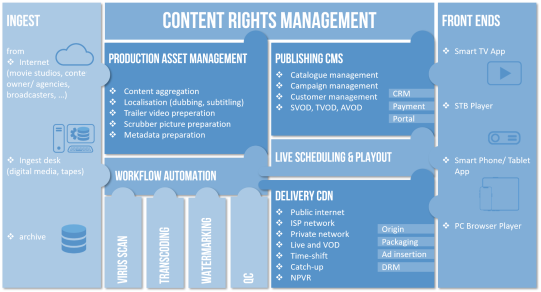
typical network architecture
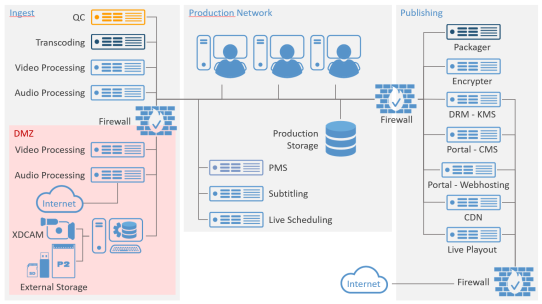
Ingest
Ingest is a topic itself. Our All Ingest Solution addresses all kinds of ingest. The complete solution or relevant elements from it can be an integral building block of the Content Sales Solution. Therefore, we focus here on typical ingest needs for content publishing.
Central Ingest Station
The Central Ingest Station is the main place for ingest operations. It's usually located in a room where all new content is brought to. Several dedicated workstations are used by a team of ingest specialists to bring files from various storage devices into the sales and delivery environment. While doing so, files are previewed, selected, pre-cut, and stitched. Technical metadata is automatically generated and descriptive metadata is added manually. The product used for this function is Woody IN2IT Access. It can transcode and re-wrap the files to the platform-internal format.
A variant of central ingest is offered when the source devices are attached to a server or files are being moved there before the ingest operations. In this case, Woody IN2IT Exchange is the right choice. Most often via watchfolders new files are detected and automatically ingested with standard metadata. If metadata is to be manually set Woody IN2IT Access can act as a client to IN2IT Exchange.
In other cases the need is more about starting an automatic workflow for a bunch of files. In this case x-dream-media's Workflow Starter allows you to remotely browse, preview, select, and segment video files via a WebGUI. Compared to Woody's IN2IT, the x-dream-media Workflow Starter sends the files for processing to x-dream-media's Workflow Manager (WFM). WFM orchestrates transcoding, re-wrapping, QC, virus scanning, and other operations. It's usually used to manage larger amounts of material.
Remote Contributors
External contributors might require high resolution video files if they are providing special effects, graphics, or low resolution for subtitles or translation. In return, they will send their work results as a source to post-production. Some contributors may have a permanent engagement. Others may provide essences occasionally and in smaller volumes, but the number of individual contributors might be quite high. Therefore, a simplified way to up- and download video files with related metadata is required. Tools have to be accessible globally and intuitive to use. We address this need by "upload and download rooms". Technically, these rooms are a website that takes or provides the essence file, and requests or provides mandatory and optional metadata. The contributor either has access to their up- or download room as they are a permanently registered user or an operator invites them to a temporary room. The essences, qualities, and functions within their room can be limited and all activity is logged.
Processing
After files and metadata have been ingested, fully automated actions can take place under the control of our Production Asset Management System (PMS): Transcoding and re-wrapping to a house format or browsing proxies, audio processing (e.g. normalising), video processing (e.g. standard conversions), and quality control.
Preparation
The asset packages to be made available on the B2B sales portal are composed from video, audio and subtitles in various languages, preview pictures in various resolutions and sizes, descriptive metadata and text in various lengths, business metadata, licensing, and pricing information. Information might come from various sources, like storage and databases, or it needs to be added manually by operators. Our production asset management system supports this process either by automatic retrieval from electronic sources or by requesting it from operators in as a software assisted process.
Publishing and Consumption
Publishing comes from the catalogue presentation on the portal, delivering the live playout, actual content delivery, and finally the presentation on the end-customers' devices.
Portal
The portal is based on a content management system and gives access to a content catalogue. Users who are not yet registered or logged in will be able to preview VOD content trailers and can check what live programming is available. The portal also manages the end-users, their subscriptions, and payments. To do so, it includes a customer relationship management system, ticketing system, and payment gateways.
Playout
The live playout is derived from a scheduling system and the stream playout engine. 24/7 schedules are built from a playlist which can be looped. The content arranged in the playlists can be taken from the VOD repository—this means the production management system can make them available for live playout. This way, a relationship between live and on-demand programs can be leveraged, for instance, to promote similar content or link to commercials for related physical goods. The sources for live scheduling can also be provided completely independent from any VOD content preparation. This might offer additional content owners to leverage the platform to sell content as a linear program.
Delivery
Once an end-customer has selected either a VOD asset or a live program to watch, an OTT streaming delivery takes place via our CDN. Certain content might require protection via a digital rights management system. This requires systems for the encryption between transcoding and delivery, the encryption key management, micro-payment or subscription management and the decryption in the players. Not forgetting buffer storage to allow additional access models like time-shift, start-over and catch-up.
Presentation
Finally, the content is presented to the end-customer on their playback device. This requires the catalogue front-end and the player plugIns for all relevant browsers, smartphones, tablets, and smart TVs. Furthermore, the players may need to support multi-language audio and subtitle handling.
service architecture of the Content Aggregation and B2C Publishing Solution
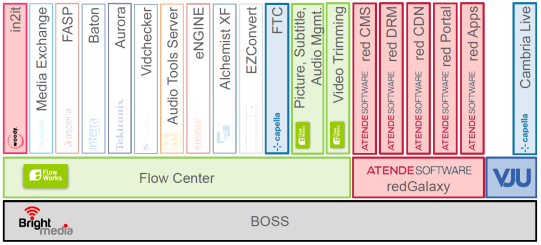
The Content License Rights Management System (RMS) is the element within our solution that tracks expenses, owned/acquired rights, and return on investment. For essence file handling, it connects to a production management system (PMS). We've selected BOSS from Bright Media as RMS within our solution.
The Production Management System (PMS) is the heart of content aggregation within our solution. It acts as the Media Asset Management System, Workflow System, and Traffic System. The PMS we've selected is FlowWork's FlowCenter. For customers with distributed organizations, the PMS can be deployed at every facility and connected to act as one global system via the flow-to-flow module.
The Transcoder and Processors are engines that help fully automate the end-to-end business process. The PMS allows integrating with any other existing or future software solution. For the transcoder, we've selected Cambria FTC from Capella Systems. Sound and video processing can happen as part of the transcoding process or in certain cases via specialized software services. Picture rendering and metadata processing are implemented based on components of the PMS. Subtitle generation and audio dubbing might be outsourced to external suppliers. For automatic transcription and translation we've selected mediawen and Aiconix. We integrate with those companies via interactive user interfaces. For automatic quality control we utilize Pulsar from our partner Venera Technologies and for manual quality control, we offer review user interfaces.
The Content Management System (CMS) is the backend of the content portal. This integrates with the player applications for browsers, smartphones, tablets, and smart TVs, the Customer Relation Management System (CRM) and the payment gateways.
The Content Delivery Network (CDN) is a distributed server network that takes the VOD or live content to the end-customers' devices. It includes functionality for time-shift, start-over, catch-up, and on-demand consumption. It also manages the content encryption as a basic function of the Digital Rights Management (DRM). We have several alternative providers for CMS, CRM, CDN and DRM depending on the exact technical and business requirements.
The Live Playout provides live streams produced from files or live source streams. For this, we've selected evrideo.
Content Aggregation and B2C Publishing Solution product partners
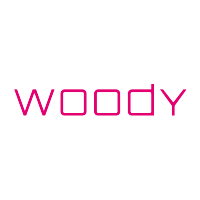
File ingest
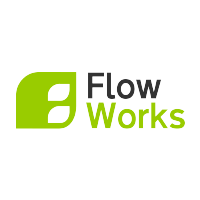
Content & workflow management
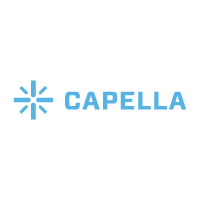
File transcoding and live transcoding

Content rights license management
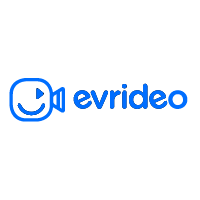
Live playout scheduling





